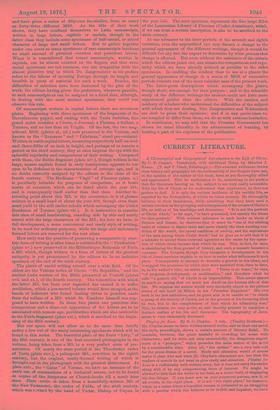CURRENT LITERATURE.
A Chronological and Geographical Introduction to the Life of Christ. By C. E. Caspari. Translated, with additional Notes, by Maurice J. Evans. (T. and T. Clark, Edinburgh.)—The external evidences drawn from history and geography for the authenticity of the Gospels have not, in the opinion of the author of this book, been as yet thoroughly sifted and appreciated. This he undertakes to do, remarking in his preface that the literature bearing on the subject is not very easily accessible. With the life of Christ, as we understand that expression, he does not profess to deal. It is only the various incidents of his earthly life, as reported by the Evangelists, of which he takes account. He thoroughly believes in their inspiration, while admitting that they have used a certain freedom in the grouping and arrangement of the events of Christ's life, as well as of his teachings and discourses. "It is not the portrait of Christ which," as he says, "is here presented, but merely the frame for that portrait." With evident reference to such books as those of Strauss and Ronan, he observes that it must be "one of the abiding teaks of science to depict more and more clearly the then existing con- dition of the world, the moral condition of society, and the aspirations of the men among whom Christ lived," but he goes on to add that it is a mistake to accept these external agencies as the cause by the opera- tion of which Jesus became that which he was. This, in fact, he says, is abandoning the firm ground of history, and such a memoir becomes a romance. The Gospels, though they recognise a development in the life of Jesus, nowhere explain to us how or under what influences it took place. Consequently to attempt to describe a growth in his ideas, and to suggest the processes by which they were modified from time to time, is, in the author's view, an entire error. "There is no trace," he says, "of progress, development, or modification," and therefore what he calls "a genetic life" of Christ is an impossibility. This seems almost as much as saying that we must not dwell on the human side of that life. We suppose the author ivpuld very decidedly object to the picture drawn of our Lord by Milton in his "Paradise Regained." His own book is far less ambitions, and its great aim is to enable us "to obtain a grasp of the history of Christ, not in the process of his becoming what he was, but in the completeness of that which he ultimately was." This, he thinks, we may arrive at, and thereby present to ourselves a distinct outline of his life and character. The topography of Jeru- salem is very elaborately discussed.






























 Previous page
Previous page